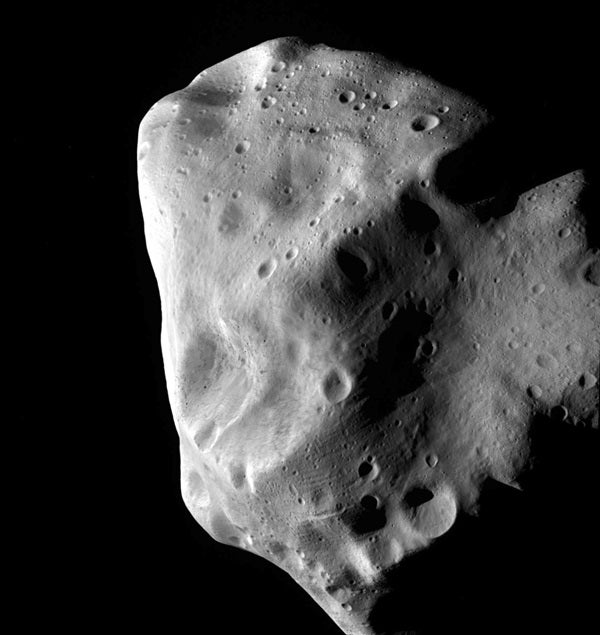A team of astronomers from French and North American universities studied the unusual asteroid Lutetia in detail at a wide range of wavelengths to deduce its composition. Data from the OSIRIS camera on ESA’s Rosetta spacecraft, ESO’s New Technology Telescope (NTT) at the La Silla Observatory in Chile, and NASA’s Infrared Telescope Facility in Hawaii and orbiting Spitzer Space Telescope were combined to create the most complete spectrum of an asteroid ever assembled.
This spectrum of Lutetia was then compared with that of meteorites found on Earth that have been extensively studied in the laboratory. Only one type of meteorite — enstatite chondrites — was found to have properties that matched Lutetia over the full range of colors.
Enstatite chondrites are known to be material that dates from the early solar system. They are thought to have formed close to the young Sun and to be a major building block in the formation of the rocky planets, in particular Earth, Venus, and Mercury. Lutetia seems to have originated not in the main belt of asteroids, where it is now, but much closer to the Sun.
“But how did Lutetia escape from the inner solar system and reach the main asteroid belt?” asked Pierre Vernazza from ESO.
Astronomers have estimated that less than 2 percent of the bodies located in the region where Earth formed ended up in the main asteroid belt. Most of the bodies of the inner solar system disappeared after a few million years as they were incorporated into the young planets that were forming. However, some of the largest, with diameters of about 60 miles (100 kilometers) or more, were ejected to safer orbits farther from the Sun.
Lutetia, which is about 60 miles (100km) across, may have been tossed out from the inner parts of the young solar system if it passed close to one of the rocky planets and, thus, had its orbit dramatically altered. An encounter with the young Jupiter during its migration to its current orbit could also account for the huge change in Lutetia’s orbit.
“We think that such an ejection must have happened to Lutetia. It ended up as an interloper in the main asteroid belt, and it has been preserved there for four billion years,” said Vernazza.
Earlier studies of its color and surface properties showed that Lutetia is an unusual and rather mysterious member of the main asteroid belt. Previous surveys have shown that similar asteroids are rare and represent less than 1 percent of the asteroid population of the main belt. The new findings explain why Lutetia is different — it is a very rare survivor of the original material that formed the rocky planets.
“Lutetia seems to be the largest, and one of the very few, remnants of such material in the main asteroid belt,” said Vernazza. “For this reason, asteroids like Lutetia represent ideal targets for future sample return missions. We could then study in detail the origin of the rocky planets, including our Earth.”
A team of astronomers from French and North American universities studied the unusual asteroid Lutetia in detail at a wide range of wavelengths to deduce its composition. Data from the OSIRIS camera on ESA’s Rosetta spacecraft, ESO’s New Technology Telescope (NTT) at the La Silla Observatory in Chile, and NASA’s Infrared Telescope Facility in Hawaii and orbiting Spitzer Space Telescope were combined to create the most complete spectrum of an asteroid ever assembled.
This spectrum of Lutetia was then compared with that of meteorites found on Earth that have been extensively studied in the laboratory. Only one type of meteorite — enstatite chondrites — was found to have properties that matched Lutetia over the full range of colors.
Enstatite chondrites are known to be material that dates from the early solar system. They are thought to have formed close to the young Sun and to be a major building block in the formation of the rocky planets, in particular Earth, Venus, and Mercury. Lutetia seems to have originated not in the main belt of asteroids, where it is now, but much closer to the Sun.
“But how did Lutetia escape from the inner solar system and reach the main asteroid belt?” asked Pierre Vernazza from ESO.
Astronomers have estimated that less than 2 percent of the bodies located in the region where Earth formed ended up in the main asteroid belt. Most of the bodies of the inner solar system disappeared after a few million years as they were incorporated into the young planets that were forming. However, some of the largest, with diameters of about 60 miles (100 kilometers) or more, were ejected to safer orbits farther from the Sun.
Lutetia, which is about 60 miles (100km) across, may have been tossed out from the inner parts of the young solar system if it passed close to one of the rocky planets and, thus, had its orbit dramatically altered. An encounter with the young Jupiter during its migration to its current orbit could also account for the huge change in Lutetia’s orbit.
“We think that such an ejection must have happened to Lutetia. It ended up as an interloper in the main asteroid belt, and it has been preserved there for four billion years,” said Vernazza.
Earlier studies of its color and surface properties showed that Lutetia is an unusual and rather mysterious member of the main asteroid belt. Previous surveys have shown that similar asteroids are rare and represent less than 1 percent of the asteroid population of the main belt. The new findings explain why Lutetia is different — it is a very rare survivor of the original material that formed the rocky planets.
“Lutetia seems to be the largest, and one of the very few, remnants of such material in the main asteroid belt,” said Vernazza. “For this reason, asteroids like Lutetia represent ideal targets for future sample return missions. We could then study in detail the origin of the rocky planets, including our Earth.”










